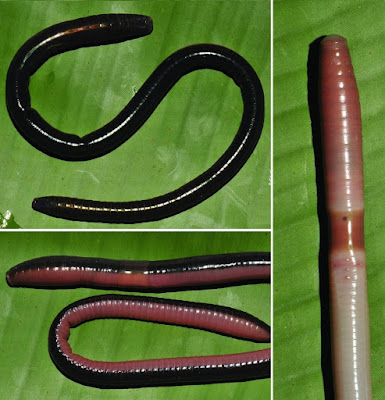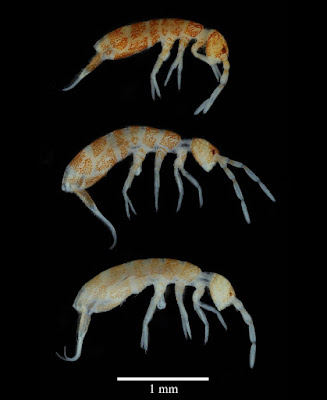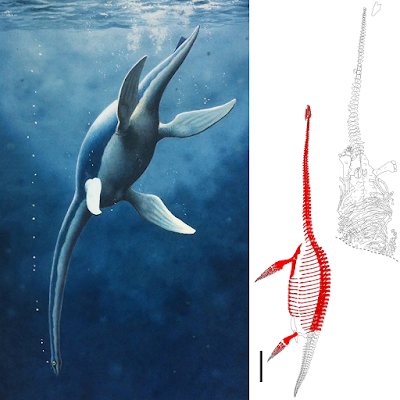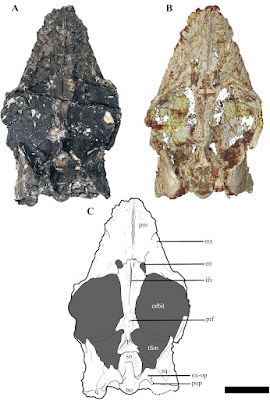[Most Recent Entries] [Calendar View]
Wednesday, April 1st, 2020
| Time | Event | ||||
| 9:36a | [Invertebrate • 2020] Amynthas whitteni • A New Species of Earthworm (Clitellata: Megascolecidae) from Mawlamyine, Myanmar
Abstract Amynthas whitteni, a new species of earthworm from Mawlamyine, Myanmar, is described herein based on anatomical and morphological characteristics. The new species belongs to the andersoni species group and is closely related to Amynthas andersoni, but was easily distinguished from it by the position and shape of the postclitellar genital markings. Key words: Amynthas, earthworms, Megascolecidae, Myanmar Family Megascolecidae Rosa, 1891 Amynthas Kinberg, 1867 Amynthas whitteni, new species Diagnosis. Length 190–265 mm, diameter 8.5–10 mm, segments 98–152. Male pores paired in XVIII, each represented by a glandular area, genital markings unpaired, midventral (MV) in intersegments 17/18–19/20; sometimes in 20/21. Spermathecal pore paired, minute in intersegments 5/6–8/9. Spermathecae large ovoid sac, diverticulum as long as ampulla, weakly crooked in middle. Holandric, intestinal caeca simple, first dorsal pore in 12/13. Prostate gland compact in XVII–XVIII, its duct long and U-shaped. No genital marking glands. Etymology. Amynthas whitteni is named in honour of the late Dr. Tony Whitten of FFI, who contributed extensively to our knowledge of cave invertebrates and initiated several projects on Asian biodiversity from Indonesia to China, Vietnam and Myanmar. Ueangfa Bantaowong, Ratmanee Chanabun and Somsak Panha. 2020. Amynthas whitteni, A New Species of Earthworm from Mawlamyine, Myanmar (Clitellata: Megascolecidae). RAFFLES BULLETIN OF ZOOLOGY. Supplement No. 35; 17-21. | ||||
| 9:51a | [Invertebrate • 2020] Alloscopus whitteni & A. namtip • Two New Species of Alloscopus (Hexapoda: Collembola) from Caves in Thailand, with A Key to World Species of the Genus
Abstract Two new cave species of the Collembola genus Alloscopus are described from southern Thailand: A. whitteni from Phang Nga province and A. namtip from Surat Thani province. Both species are characterised by the absence of eyes and mucronal spine, presence of PAO, two rows of smooth chaetae on manubrium and dental spines. The two new species are different by number of macrochaetae on ‘A’ series of head and Th.II, labial basis chaetotaxy, number of labral papillae, number of chaetae on posterior ventral tube, inter teeth of claw and trochanteral spines. They also differ in rows of smooth chaetae on tibiotarsus and lateral anal valve chaetae. Antennal morphological types were thoroughly observed for the first time in the genus, of which 13 types are recognised and homologised with recent antennal chaetal categories for Verhoeffiella. The complete body chaetotaxic pattern and a key to the world species of the genus are also provided. Key words: antennal chaetotaxy, Heteromurinae, subterranean, taxonomy, southern Thailand
Family Entomobryidae Schäffer, 1896 Subfamily Heteromurinae sensu Zhang & Deharveng, 2015 Tribus Heteromurini Absolon & Ksenemann, 1942 Alloscopus Börner, 1906 Alloscopus whitteni, new species Etymology. Alloscopus whitteni pays special tribute to Tony Whitten in appreciation for his enormous contributions to nature conservation, especially in threatened karstic areas and cave fauna. Habitat. The individuals were found in soil and on the small patch of bat guano in dark zone of cave near the stream bank. Alloscopus namtip, new species Etymology. Alloscopus namtip is named for the type locality [Tham (cave) Namtip, Thachana, Surat Thani Province.] and is used as a noun in apposition. Habitat. This species was found on ground floor with small patch of bat guano in the twilight to dark zone of the cave. Sopark Jantarit and Tawin Sangsiri. 2020. Two New Species of Alloscopus from Caves in Thailand, with A Key to World Species of the Genus (Hexapoda: Collembola). RAFFLES BULLETIN OF ZOOLOGY. Supplement No. 35; 48-60. | ||||
| 10:42a | [Paleontology • 2020] Ophthalmothule cryostea • A New Plesiosaurian from the Jurassic–Cretaceous Transitional Interval of the Slottsmøya Member (Volgian), with Insights Into the Cranial Anatomy of Cryptoclidids using Computed Tomography
Abstract Cryptoclidids are a major clade of plesiosauromorph plesiosaurians best known from the Middle—Late Jurassic, but little is known regarding their turnover into the Early Cretaceous. Of the known cryptoclidid genera, most preserve only a limited amount of cranial material and of these Cryptoclidus eurymerus, displays the most complete, but compressed cranium. Thus, the lack of knowledge of the cranial anatomy of this group may hinder the understanding of phylogenetic interrelationships, which are currently predominantly based on postcranial data. Here we present a nearly complete adult cryptoclidid specimen (PMO 224.248) representing a new genus and species Ophthalmothule cryostea gen et sp. nov., from the latest Jurassic to earliest Cretaceous part of the Slottsmøya Member, of central Spitsbergen. The holotype material preserves a complete cranium, partial mandible, complete and articulated cervical, pectoral and anterior to middle dorsal series, along with the pectoral girdle and anterior humeri. High resolution microcomputed tomography reveals new data on the cranial anatomy of this cryptoclidid, including new internal features of the braincase and palate that are observed in other cryptoclidids. A phylogenetic analysis incorporating new characters reveals a novel tree topology for Cryptoclididae and particularly within the subfamily Colymbosaurinae. These results show that at least two cryptoclidid lineages were present in the Boreal Region during the latest Jurassic at middle to high latitudes. Systematic Palaeontology Sauropterygia Owen, 1860 Plesiosauria de Blainville, 1835 Plesiosauroidea Welles, 1934 Cryptoclididae Williston, 1925 Ophthalmothule gen. nov. Ophthalmothule cryostea sp. nov. Holotype: PMO 224.248 Occurrence: The holotype specimen PMO 224.248 was excavated from the north-facing slopes of Wimanfjellet (Mt. Wiman), from the upper part of the Slottsmøya Member, Agardhfjellet Formation, central Spitsbergen: GPS coordinates UTM 33X E523620 N8696396 (Fig. 1). The specimen was located 38.5 m above the yellow storm deposit marker bed (0 m in log), and is late Volgian (latest Tithonian/ early Berriasian) in age. Etymology: Ophthalmothule. Ophthalmo, meaning eye. Thule is a term used for the northern-most region of the world. Together they make “North eye”. Species name, cryostea, meaning “frozen bones”. Differential diagnosis: A moderately sized cryptoclidid plesiosaur (estimated body length of 5.0–5.5 m), possessing the following autapomorphies unique among Cryptoclididae (*) and unique character combinations: premaxilla bears 6 alveoli (5 in Tricleidus seeleyi and Muraenosaurus leedsii); medial process of premaxilla terminates anterior to the posterior margin of external naris (*); maxilla estimated to contain a similar number of alveoli (>16) as in in Cryptoclidus eurymerus (18) and Tricleidus seeleyi (15); frontal twice as anteroposteriorly long as parietal (subequal or shorter in Cryptoclidus eurymerus and M. leedsii); frontal participates in the medial and posterior margins of the external naris (participates posteriorly in M. leedsii); presence of an interfrontal vacuity (absent in M. leedsii); dorsoventrally low but mediolaterally narrow sagittal crest (flat and mediolaterally broad in Kimmerosaurus langhami); quadrate articulates anterolaterally to the pterygoid (posteromedially in Tricleidus seeleyi and M. leedsii); lateral cotyle of quadrate larger than medial cotyle (reversed in S. larseni); basioccipital tubera mediolaterally broad and dorsoventrally flattened (circular in K. langhami and Cryptoclidus eurymerus); ....
Conclusion: Ophthalmothule cryostea (PMO 224.248) represents the temporally youngest occurrence of a plesiosaurian from the Slottsmøya Member (Agardhfjellet Formation) of central Spitsbergen. Ophthalmothule cryostea represents the fourth genus described from the member, although several other cryptoclidid specimens remain to be described. Ophthalmothule cryostea is one of the few cryptoclidids with detailed cranial osteology available, providing much needed morphological information for understanding the interrelationships of cryptoclidids. In addition, this specimen uniquely preserves a complete cervical series found in articulation, offering future possibilties to test current hypotheses on plesiosaurian neck-flexibility and evolution. As the specimen was found in the section encompassing the Jurassic–Cretaceous boundary, Ophthalmothule cryostea along with the Russian Abyssosaurus nataliae represent the youngest cryptoclidid genera in Boreal and sub-Boreal regions. The phylogenetic results of this study indicate that two separate clades of cryptoclidids were present in the latest Jurassic in the Boreal region of Spitsbergen and the sub-Boreal region of Russia. Aubrey Jane Roberts, Patrick S. Druckenmiller, Benoit Cordonnier, Lene L. Delsett and Jørn H. Hurum. 2020. A New Plesiosaurian from the Jurassic–Cretaceous Transitional Interval of the Slottsmøya Member (Volgian), with Insights Into the Cranial Anatomy of Cryptoclidids using Computed Tomography. PeerJ. 8:e8652. DOI: 10.7717/peerj.8652 Aubrey Jane Roberts gravde frem en sensasjon fra fjellet på Svalbard nrk.no/viten/xl/1.14921060 |
| << Previous Day |
2020/04/01 [Calendar] |
Next Day >> |











